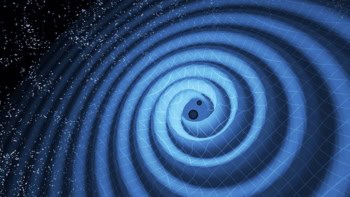Suggestions that Newton’s inverse-square law of gravitation falters on astronomical scales may have been ruled-out by a study of planetary orbits performed in Italy. Lorenzo Iorio of the Università di Bari has worked out that modifications to Newton’s law operating on ranges greater than one tenth of the distance from the Earth to the Sun are not compatible with the known orbits of Mercury and Earth (arXiv.org:0708.1080v3).
To write down a successful “theory of everything”, physicists need to know why gravity is many orders of magnitude weaker than the other three fundamental forces of nature. One explanation is that gravity leaks into extra dimensions, leaving us to feel a mere fraction of its attractive force.
Most theories predict that these dimensions would be no larger than a millimetre or so. But some say extra dimensions could be non-compact, meaning that odd gravitational effects would occur at astronomical distances. In the past, such long-range effects have also been put forward to explain the odd trajectories of NASA’s disused Pioneer 10 and 11 probes, which appear to be being affected by a small additional force as they leave the Solar System.
Iorio’s study, however, discredits ideas of long-range effects. He has examined a general class of theories that add “Yukawa” modifications to Newton’s inverse-square law of gravitation, which allow gravity’s attractive force to fall more or less rapidly with distance. He has then calculated how much several different modifications would affect the Newtonian time-varying “perihelion” – the closest point in an orbit to the Sun – of Earth and Mercury.
Physicists can already simulate how the planets’ perihelia change over time to a reasonable accuracy using Newton’s and Einstein’s theories of gravity, but have always had to make small corrections to make them fit observational data. Iorio has checked whether the sizes of his calculated effects from different Yukawa modifications are small enough to fit within these corrections.
He found that the only modifications compatible were those that operated on a range less than a tenth of the distance from the Earth to the Sun, or 0.1 AU. However, he warns that more evidence from other perihelia corrections would be needed before Yukawa modifications with a range greater than 0.1 AU can be ruled-out with certainty.
Orfeu Bertolami, a theoretical physicist from the Instituto Superior Técnico in Portugal, seconds Iorio’s caution. “I am not sure that the study of the perihelia of some planets is sufficient to draw any definite conclusion,” he told physicsworld.com. “A new contribution for the gravitational force affects the whole orbit of the planets and not just the perihelia motion.”



